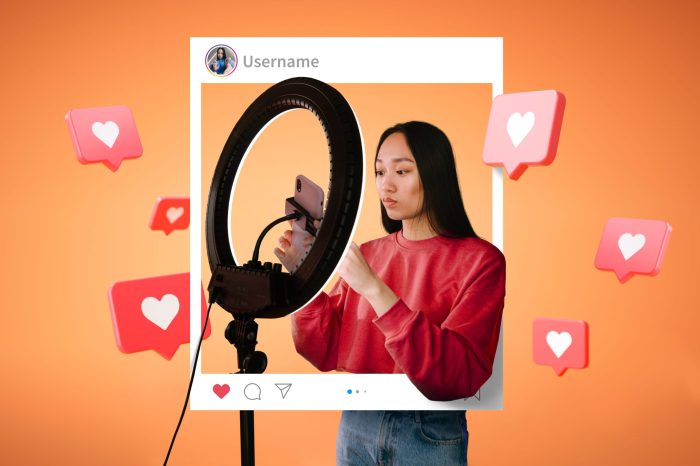Influencer Marketing Guide sets the stage for this enthralling narrative, offering readers a glimpse into a story that is rich in detail with american high school hip style and brimming with originality from the outset.
In today’s digital age, leveraging influencers has become a powerful marketing strategy for brands looking to reach their target audience authentically and effectively. From defining influencer marketing to exploring different types of influencers and crafting successful campaigns, this guide covers it all. Dive into the world of influencer marketing and discover how to elevate your brand’s presence in the online realm.
Overview of Influencer Marketing
Influencer marketing is a form of advertising where brands collaborate with individuals who have a strong social media presence to promote their products or services. In today’s digital age, influencer marketing has become increasingly popular due to its ability to reach a highly engaged audience and build authentic connections with consumers.
Benefits of Influencer Marketing
- Increased brand awareness: Influencers have a loyal following who trust their recommendations, leading to greater exposure for your brand.
- Improved credibility: Consumers perceive influencer endorsements as more trustworthy than traditional ads, enhancing your brand’s credibility.
- Targeted reach: Influencers can help you reach specific demographics or niche markets that align with your target audience.
- Engagement and authenticity: Influencers create authentic content that resonates with their followers, driving higher engagement rates for your brand.
Successful Influencer Marketing Campaigns
- Kylie Jenner x Adidas: Kylie Jenner’s collaboration with Adidas for their Falcon sneakers generated massive buzz and sold out quickly, showcasing the power of influencer partnerships.
- Daniel Wellington x Influencers: The watch brand Daniel Wellington leveraged influencer marketing to grow their brand from a startup to a global success story, thanks to strategic partnerships with fashion influencers.
- Flat Tummy Tea x Instagram Influencers: Flat Tummy Tea’s campaign with Instagram influencers led to a significant increase in sales and brand visibility, demonstrating the impact of influencer endorsements on consumer behavior.
Impact of Influencer Marketing on Consumer Behavior
- Increased purchase intent: Studies have shown that consumers are more likely to purchase a product recommended by an influencer they follow, leading to higher conversion rates.
- Authenticity and trust: Influencers build authentic relationships with their followers, fostering trust and credibility that translates into consumer loyalty towards endorsed brands.
- Social proof and FOMO: Influencer endorsements create a sense of social proof and fear of missing out (FOMO) among consumers, driving them to make purchase decisions based on influencer recommendations.
Types of Influencers
In the world of influencer marketing, different types of influencers play a crucial role in reaching target audiences and driving engagement for brands. From micro-influencers to celebrities, each type brings a unique set of benefits and considerations.
Micro-Influencers
Micro-influencers are individuals with a smaller but highly engaged following, typically ranging from 1,000 to 100,000 followers. While their reach may be limited compared to macro or celebrity influencers, micro-influencers often have a more niche and loyal audience, leading to higher engagement rates.
- Micro-influencers are known for their authenticity and ability to connect with their followers on a personal level.
- Brands like Glossier and MVMT have successfully collaborated with micro-influencers to create genuine and relatable content.
Macro-Influencers
Macro-influencers have a larger following, usually between 100,000 to 1 million followers. They offer a wider reach and can help brands target a broader audience. However, their engagement rates may vary depending on the level of connection they have with their followers.
- Macro-influencers like Chiara Ferragni and PewDiePie have worked with brands such as Adidas and Pepsi to promote products to a mass audience.
- While they may have a higher reach, the authenticity of their endorsements can sometimes be questioned.
Celebrities
Celebrities are influencers with millions of followers, often from their careers in entertainment, sports, or other industries. Their endorsement can significantly impact brand awareness and sales, but the cost of collaboration is usually much higher compared to other types of influencers.
- Celebrities like Kim Kardashian and Cristiano Ronaldo have partnered with brands like Calvin Klein and Nike to promote products to a global audience.
- While their reach is extensive, the level of engagement and authenticity in their endorsements may vary.
Finding the Right Influencers
When it comes to finding the right influencers for your brand, it’s essential to target individuals who align with your niche and have an engaged following. Here are some methods and tips to help you in your search:
Identifying Relevant Influencers
One way to identify relevant influencers is by conducting thorough research within your industry. Look for individuals who are already talking about topics related to your brand or product.
Tools and Platforms for Finding Influencers
- Utilize social media listening tools like Brandwatch or Mention to track relevant conversations and identify potential influencers.
- Platforms like Upfluence, AspireIQ, and Influence.co can help you discover and connect with influencers in your niche.
Evaluating Authenticity and Engagement
When evaluating an influencer, look beyond just their follower count. Pay attention to their engagement rate, content quality, and authenticity. Tools like Social Blade can provide insights into an influencer’s audience and engagement metrics.
Negotiating Terms and Agreements
- Clearly define expectations, deliverables, and compensation before entering into an agreement with an influencer.
- Consider working with micro-influencers who may offer more targeted reach and better engagement rates compared to macro-influencers.
Crafting an Influencer Marketing Strategy
Crafting a successful influencer marketing strategy involves several key steps to ensure effective collaboration with influencers and achieve campaign objectives. Setting clear goals and objectives is crucial for guiding influencer campaigns, while creative collaboration ideas can help maximize the impact of partnerships. Additionally, measuring the effectiveness of influencer marketing efforts is essential for evaluating ROI and optimizing future strategies.
Setting Clear Goals and Objectives
Before embarking on an influencer marketing campaign, it is important to define specific goals and objectives to guide the collaboration. This can include increasing brand awareness, driving website traffic, boosting sales, or engaging with a target audience.
- Define key performance indicators (KPIs) to measure the success of the campaign.
- Establish specific, measurable, achievable, relevant, and time-bound (SMART) goals.
- Align influencer selection, content creation, and distribution strategies with campaign objectives.
Creative Collaboration Ideas
To stand out in a crowded influencer landscape, brands can explore innovative ways to collaborate with influencers that resonate with their audience and drive engagement.
- Create unique branded content that showcases the influencer’s personality and aligns with the brand’s values.
- Host interactive events, contests, or giveaways with influencers to generate buzz and foster community engagement.
- Partner with influencers on long-term ambassador programs to build authentic relationships and loyalty with their followers.
Measuring Effectiveness of Influencer Marketing Efforts
Tracking and analyzing the performance of influencer campaigns is essential for refining strategies, optimizing ROI, and demonstrating the impact of collaborations.
- Monitor engagement metrics such as likes, comments, shares, and click-through rates to gauge audience response.
- Use tracking links, promo codes, or UTM parameters to attribute conversions and sales generated by influencer content.
- Utilize influencer marketing platforms and analytics tools to measure campaign performance and ROI accurately.
Legal and Ethical Considerations

Influencer marketing is not just about creating engaging content and reaching a wide audience. There are legal and ethical considerations that influencers and brands need to keep in mind to ensure transparency and compliance with regulations.
Legal Requirements and Guidelines, Influencer Marketing Guide
When working on influencer marketing campaigns, it is essential to follow the legal requirements and guidelines set by the Federal Trade Commission (FTC). This includes disclosing any sponsored content and ensuring that the audience is aware of any paid partnerships.
Disclosure of Sponsored Content
Transparency is key in influencer marketing. Influencers must clearly disclose any sponsored content by using hashtags like #ad or #sponsored. This helps maintain trust with their audience and ensures compliance with FTC regulations.
Avoiding Common Pitfalls
To avoid controversies in influencer partnerships, it is crucial to be transparent about any financial relationships. Avoid misleading claims or deceptive practices that could harm your reputation and credibility as an influencer.
Examples of Ethical Influencer Marketing
Some examples of influencer marketing done ethically and transparently include partnering with brands that align with your values, clearly disclosing sponsored content, and maintaining authenticity in your content. By following these best practices, influencers can build trust with their audience and create successful partnerships.
Trends in Influencer Marketing
In the fast-paced world of influencer marketing, staying on top of the latest trends is crucial for brands looking to make a mark. Let’s dive into some of the key trends shaping the industry today.
The Rise of Nano Influencers
Nano influencers, with smaller but highly engaged followings, are gaining popularity among brands. These influencers typically have a few thousand followers, allowing for more authentic and personal connections with their audience. This trend highlights the shift towards micro-level influencers who can drive meaningful engagement and conversions for brands.
Importance of Authenticity and Storytelling
Authenticity and storytelling have become paramount in influencer content. Audiences are increasingly craving genuine connections and relatable stories from influencers. Brands are leveraging this trend by partnering with influencers who can authentically integrate their products or services into engaging narratives, creating a more impactful message for consumers.
Innovative Influencer Marketing Campaigns
From interactive social media challenges to immersive virtual experiences, brands are pushing the boundaries with innovative influencer marketing campaigns. For example, collaborating with influencers to co-create limited-edition products or hosting live events with influencer meet-and-greets. These creative approaches not only capture the attention of audiences but also drive brand awareness and loyalty in unique ways.
Measuring Success in Influencer Marketing: Influencer Marketing Guide

Influencer marketing campaigns can be a powerful way to reach your target audience and drive engagement. However, it’s essential to measure the success of these campaigns to ensure they are delivering the desired results. Key performance indicators (KPIs) play a crucial role in evaluating the effectiveness of influencer collaborations. By tracking these metrics, brands can determine the impact of their partnerships and make informed decisions for future strategies.
Key Performance Indicators (KPIs)
- Engagement Rate: This metric measures the level of interaction generated by the influencer’s content, including likes, comments, and shares. A high engagement rate indicates that the audience is actively engaging with the brand.
- Reach: The reach metric calculates the number of people who have seen the influencer’s content. It helps brands understand the potential exposure their campaign is receiving.
- Conversion Rate: Tracking the conversion rate allows brands to see how many of the influencer’s followers took the desired action, such as making a purchase or signing up for a newsletter.
Tools and Analytics for Tracking Success
- Google Analytics: This tool provides detailed insights into website traffic, referral sources, and conversion rates resulting from influencer campaigns.
- Social Media Analytics: Platforms like Instagram, Facebook, and Twitter offer analytics tools to track the performance of influencer posts, including reach, engagement, and demographics.
- Influencer Marketing Platforms: These platforms help brands manage and track influencer collaborations, providing data on performance metrics and ROI.
Interpreting Data for Optimization
- Identify Trends: Look for patterns in the data to understand what content resonates most with the audience and adjust future strategies accordingly.
- A/B Testing: Experiment with different approaches to influencer campaigns to determine what drives the best results and optimize for future partnerships.
- Feedback Loop: Communicate with influencers to gather insights on what worked well and areas for improvement, fostering a collaborative approach to campaign optimization.
Case Studies of Effective ROI Measurement
Brand X collaborated with Influencer Y for a product launch campaign, resulting in a 20% increase in sales and a 15% growth in brand awareness.
Brand Z tracked the engagement rate of Influencer A’s posts and saw a 30% boost in website traffic and a 25% increase in conversions.





